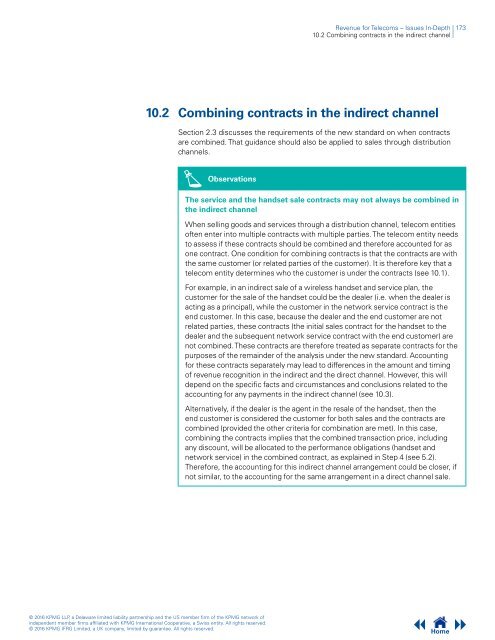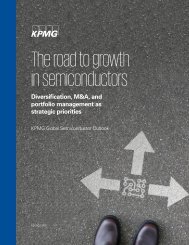Revenue for Telecoms
2cdncba
2cdncba
Create successful ePaper yourself
Turn your PDF publications into a flip-book with our unique Google optimized e-Paper software.
<strong>Revenue</strong> <strong>for</strong> <strong>Telecoms</strong> – Issues In-Depth | 173<br />
10.2 Combining contracts in the indirect channel |<br />
10.2 Combining contracts in the indirect channel<br />
Section 2.3 discusses the requirements of the new standard on when contracts<br />
are combined. That guidance should also be applied to sales through distribution<br />
channels.<br />
Observations<br />
The service and the handset sale contracts may not always be combined in<br />
the indirect channel<br />
When selling goods and services through a distribution channel, telecom entities<br />
often enter into multiple contracts with multiple parties. The telecom entity needs<br />
to assess if these contracts should be combined and there<strong>for</strong>e accounted <strong>for</strong> as<br />
one contract. One condition <strong>for</strong> combining contracts is that the contracts are with<br />
the same customer (or related parties of the customer). It is there<strong>for</strong>e key that a<br />
telecom entity determines who the customer is under the contracts (see 10.1).<br />
For example, in an indirect sale of a wireless handset and service plan, the<br />
customer <strong>for</strong> the sale of the handset could be the dealer (i.e. when the dealer is<br />
acting as a principal), while the customer in the network service contract is the<br />
end customer. In this case, because the dealer and the end customer are not<br />
related parties, these contracts (the initial sales contract <strong>for</strong> the handset to the<br />
dealer and the subsequent network service contract with the end customer) are<br />
not combined. These contracts are there<strong>for</strong>e treated as separate contracts <strong>for</strong> the<br />
purposes of the remainder of the analysis under the new standard. Accounting<br />
<strong>for</strong> these contracts separately may lead to differences in the amount and timing<br />
of revenue recognition in the indirect and the direct channel. However, this will<br />
depend on the specific facts and circumstances and conclusions related to the<br />
accounting <strong>for</strong> any payments in the indirect channel (see 10.3).<br />
Alternatively, if the dealer is the agent in the resale of the handset, then the<br />
end customer is considered the customer <strong>for</strong> both sales and the contracts are<br />
combined (provided the other criteria <strong>for</strong> combination are met). In this case,<br />
combining the contracts implies that the combined transaction price, including<br />
any discount, will be allocated to the per<strong>for</strong>mance obligations (handset and<br />
network service) in the combined contract, as explained in Step 4 (see 5.2).<br />
There<strong>for</strong>e, the accounting <strong>for</strong> this indirect channel arrangement could be closer, if<br />
not similar, to the accounting <strong>for</strong> the same arrangement in a direct channel sale.<br />
© 2016 KPMG LLP, a Delaware limited liability partnership and the US member firm of the KPMG network of<br />
independent member firms affiliated with KPMG International Cooperative, a Swiss entity. All rights reserved.<br />
© 2016 KPMG IFRG Limited, a UK company, limited by guarantee. All rights reserved.<br />
Home







